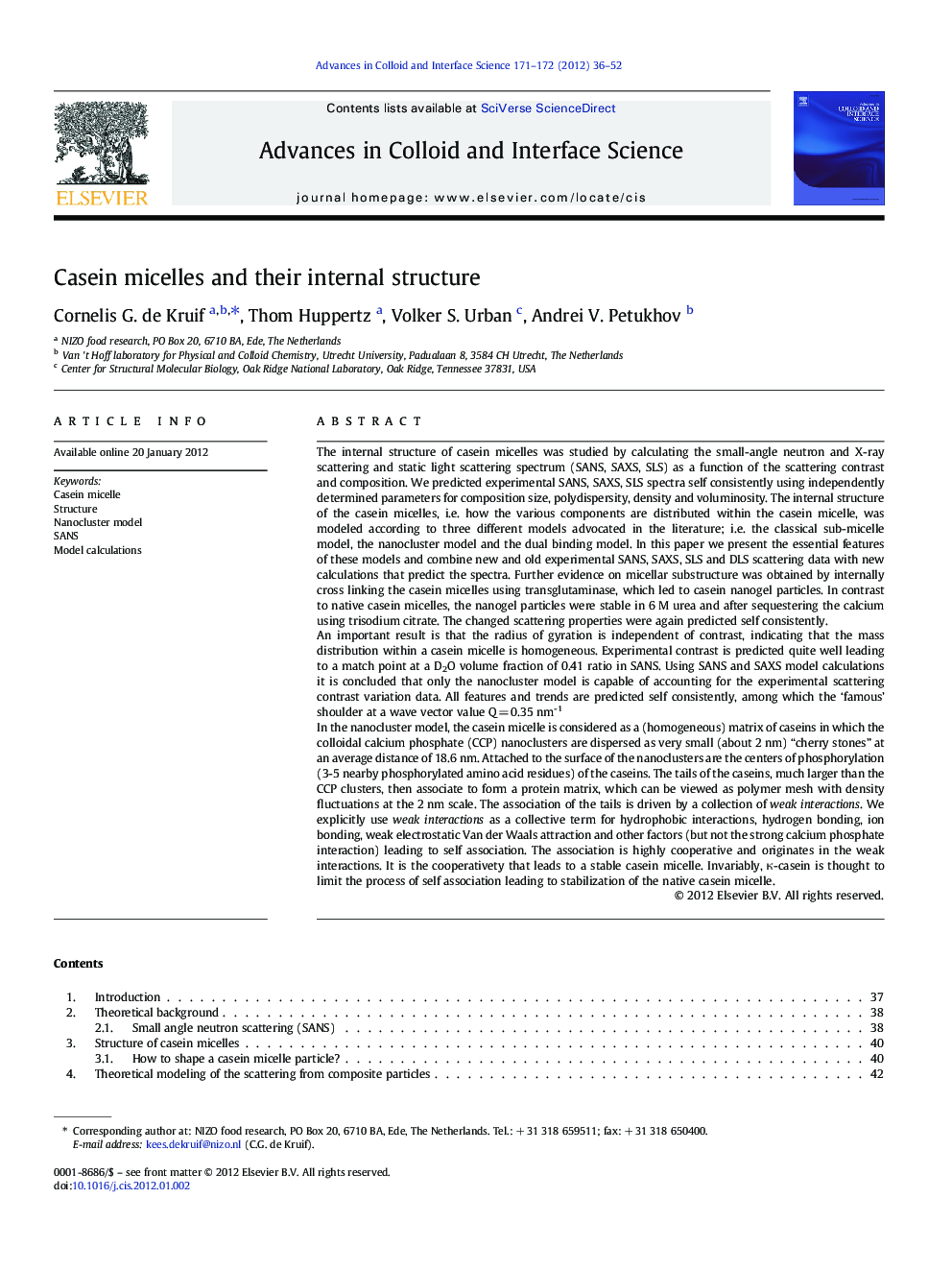| Article ID | Journal | Published Year | Pages | File Type |
|---|---|---|---|---|
| 590930 | Advances in Colloid and Interface Science | 2012 | 17 Pages |
The internal structure of casein micelles was studied by calculating the small-angle neutron and X-ray scattering and static light scattering spectrum (SANS, SAXS, SLS) as a function of the scattering contrast and composition. We predicted experimental SANS, SAXS, SLS spectra self consistently using independently determined parameters for composition size, polydispersity, density and voluminosity. The internal structure of the casein micelles, i.e. how the various components are distributed within the casein micelle, was modeled according to three different models advocated in the literature; i.e. the classical sub-micelle model, the nanocluster model and the dual binding model. In this paper we present the essential features of these models and combine new and old experimental SANS, SAXS, SLS and DLS scattering data with new calculations that predict the spectra. Further evidence on micellar substructure was obtained by internally cross linking the casein micelles using transglutaminase, which led to casein nanogel particles. In contrast to native casein micelles, the nanogel particles were stable in 6 M urea and after sequestering the calcium using trisodium citrate. The changed scattering properties were again predicted self consistently.An important result is that the radius of gyration is independent of contrast, indicating that the mass distribution within a casein micelle is homogeneous. Experimental contrast is predicted quite well leading to a match point at a D2O volume fraction of 0.41 ratio in SANS. Using SANS and SAXS model calculations it is concluded that only the nanocluster model is capable of accounting for the experimental scattering contrast variation data. All features and trends are predicted self consistently, among which the ‘famous’ shoulder at a wave vector value Q = 0.35 nm-1In the nanocluster model, the casein micelle is considered as a (homogeneous) matrix of caseins in which the colloidal calcium phosphate (CCP) nanoclusters are dispersed as very small (about 2 nm) “cherry stones” at an average distance of 18.6 nm. Attached to the surface of the nanoclusters are the centers of phosphorylation (3-5 nearby phosphorylated amino acid residues) of the caseins. The tails of the caseins, much larger than the CCP clusters, then associate to form a protein matrix, which can be viewed as polymer mesh with density fluctuations at the 2 nm scale. The association of the tails is driven by a collection of weak interactions. We explicitly use weak interactions as a collective term for hydrophobic interactions, hydrogen bonding, ion bonding, weak electrostatic Van der Waals attraction and other factors (but not the strong calcium phosphate interaction) leading to self association. The association is highly cooperative and originates in the weak interactions. It is the cooperativety that leads to a stable casein micelle. Invariably, κ-casein is thought to limit the process of self association leading to stabilization of the native casein micelle.
Graphical abstractFigure optionsDownload full-size imageDownload as PowerPoint slideHighlights► The internal structure of a casein micelle consists of a protein matrix in which calcium phosphate nanoclusters of about 2 nm radius are dispersed. ► The protein matrix has density fluctuations on a scale of a about two nm radius. ► A casein micelle contains about 285 nanoclusters and five times more protein clusters. ► In pooled milk a casein micelle has a volume average radius of 61 nm and a polydispersity of 0.35. ► A new method for calculating scattering spectra of composite particles is presented.
